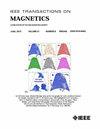调节Fe3O4的居里温度实现自动磁热疗
IF 1.9
3区 工程技术
Q3 ENGINEERING, ELECTRICAL & ELECTRONIC
引用次数: 0
摘要
通过密度泛函理论(DFT)计算,研究了钐掺杂对磁铁矿居里温度($T_{c}$)的影响。通过计算Fe 304:Sm中不同自旋方向阳离子的总能量,我们意识到Sm原子更倾向于用与被取代原子相反的自旋取代来自八面体位置的Fe原子。结果表明,Sm掺杂削弱了八面体和四面体铁原子之间的铁磁J耦合。结果表明,在较宽的温度范围内,归一化磁化谱显示,掺钐化合物(Fe3O4:Sm)的T_{c}$约为319 K,这与自调节磁性纳米粒子热疗(MNH)应用的目标范围很好地吻合。此外,我们证明了Sm在磁铁矿中掺杂的高电子浓度$10^{23}\ mathm {~cm}^{-3}$和$10^{23}\ mathm {~cm}^{-3}$几乎保留了霍尔系数($R_{H}$),这意味着Fe3O4:Sm可以在不显著改变磁铁矿基于霍尔效应的肿瘤组织识别能力的情况下合成。本文章由计算机程序翻译,如有差异,请以英文原文为准。
Tuning the Curie Temperature of Fe3O4 to Achieve Automated Magnetic Hyperthermia
We examine the impact of samarium doping on the Curie temperature ( $T_{c}$ ) of magnetite through density functional theory (DFT) calculations. Upon calculating the total energies of the different spin orientations among the cations in Fe 3O 4:Sm, we realized that the Sm atom prefers to substitute an Fe from the octahedral site with a spin opposing that of the atom it replaces. Our results show that Sm doping weakens the ferrimagnetic J coupling between the octahedral and tetrahedral Fe atoms. As a result, the normalized magnetization profile across a broad temperature range shows that the samarium-doped compound (Fe3O4:Sm) has a $T_{c}$ of approximately 319 K, which aligns well with the target range for self-regulated magnetic nanoparticle hyperthermia (MNH) applications. Furthermore, we demonstrated that Sm doping in magnetite with high electron concentrations of $10^{22} \mathrm{~cm}^{-3}$ and $10^{23} \mathrm{~cm}^{-3}$ almost nearly preserves the Hall coefficient ( $R_{H}$ ), implying that Fe3O4:Sm can be synthesized without significantly altering magnetite’s ability for tumor tissue identification based on the Hall effect.
求助全文
通过发布文献求助,成功后即可免费获取论文全文。
去求助
来源期刊

IEEE Transactions on Magnetics
工程技术-工程:电子与电气
CiteScore
4.00
自引率
14.30%
发文量
565
审稿时长
4.1 months
期刊介绍:
Science and technology related to the basic physics and engineering of magnetism, magnetic materials, applied magnetics, magnetic devices, and magnetic data storage. The IEEE Transactions on Magnetics publishes scholarly articles of archival value as well as tutorial expositions and critical reviews of classical subjects and topics of current interest.
 求助内容:
求助内容: 应助结果提醒方式:
应助结果提醒方式:


